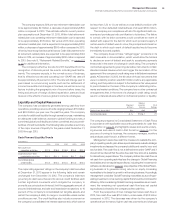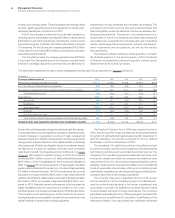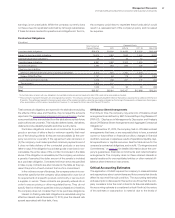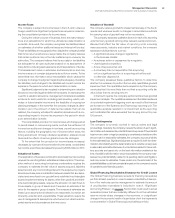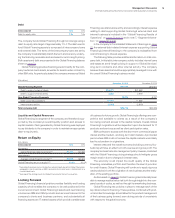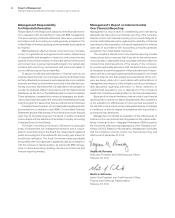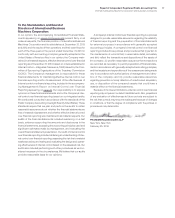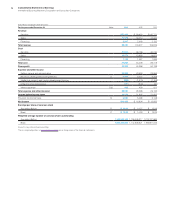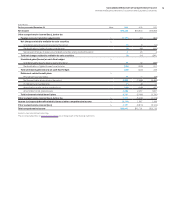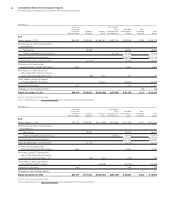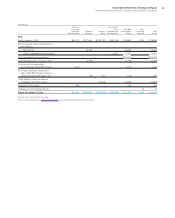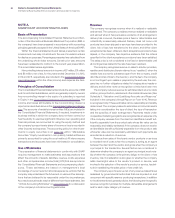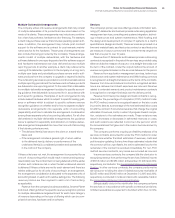IBM 2013 Annual Report Download - page 76
Download and view the complete annual report
Please find page 76 of the 2013 IBM annual report below. You can navigate through the pages in the report by either clicking on the pages listed below, or by using the keyword search tool below to find specific information within the annual report.
75
Management Discussion
International Business Machines Corporation and Subsidiary Companies
Debt
At December 31: 2013 2012
Debt-to-equity ratio 7.2x 7.0x
The company funds Global Financing through borrowings using a
debt-to-equity ratio target of approximately 7 to 1. The debt used to
fund Global Financing assets is composed of intercompany loans
and external debt. The terms of the intercompany loans are set by
the company to substantially match the term and currency underly-
ing the financing receivable and are based on arm’s-length pricing.
Both assets and debt are presented in the Global Financing balance
sheet on page 73.
Global Financing provides financing predominantly for the com-
pany’s external client assets, as well as for assets under contract by
other IBM units. As previously stated, the company measures Global
Financing as a stand-alone entity, and accordingly, interest expense
relating to debt supporting Global Financing’s external client and
internal business is included in the “Global Financing Results of
Operations” on pages 72 and 73 and in note T, “Segment Informa-
tion,” on pages 141 to 146.
In the company’s Consolidated Statement of Earnings on page
78, the external debt-related interest expense supporting Global
Financing’s internal financing to the company is reclassified from
cost of financing to interest expense.
The following table provides additional information on total com-
pany debt. In this table, intercompany activity includes internal loans
and leases at arm’s-length pricing in support of Global Services’
long-term contracts and other internal activity. The company
believes these assets should be appropriately leveraged in line with
the overall Global Financing business model.
($ in millions)
December 31, 2013 December 31, 2012
Global Financing Segment $27,504 $24,501
Debt to support external clients $24,471 $21,583
Debt to support internal clients 3,033 2,919
Non-Global Financing Segments 12,214 8,767
Debt supporting operations 15,247 11,686
Intercompany activity (3,033) (2,919)
Total company debt $39,718 $33,269
Liquidity and Capital Resources
Global Financing is a segment of the company, and therefore is sup-
ported by the company’s overall liquidity position and access to
capital markets. Cash generated by Global Financing was deployed
to pay dividends to the company in order to maintain an appropriate
debt-to-equity ratio.
Return on Equity
($ in millions)
At December 31: 2013 2012
Numerator
Global Financing after-tax income
(a)*$1,456 $1,362
Denominator
Average Global Financing equity
(b)** $3,585 $3,322
Global Financing return on equity
(a) /(b) 40.6% 41.0%
* Calculated based upon an estimated tax rate principally based on Global Financing’s
geographic mix of earnings as IBM’s provision for income taxes is determined on a
consolidated basis.
** Average of the ending equity for Global Financing for the last five quarters.
Looking Forward
Global Financing’s financial position provides flexibility and funding
capacity which enables the company to be well positioned in the
current environment. Global Financing’s assets and new financing
volumes are IBM and OEM products and services financed to the
company’s clients and business partners, and substantially all
financing assets are IT related assets which provide a stable base
of business for future growth. Global Financing’s offerings are com-
petitive and available to clients as a result of the company’s
borrowing cost and access to the capital markets. Overall, Global
Financing’s originations will be dependent upon the demand for IT
products and services as well as client participation rates.
IBM continues to access both the short-term commercial paper
market and the medium- and long-term debt markets. A protracted
period where IBM could not access the capital markets would likely
lead to a slowdown in originations.
Interest rates and the overall economy (including currency fluc-
tuations) will have an effect on both revenue and gross profit. The
company’s interest rate risk management policy, however, combined
with the Global Financing pricing strategy should mitigate gross
margin erosion due to changes in interest rates.
The economy could impact the credit quality of the Global
Financing receivables portfolio and therefore the level of provision
for credit losses. Global Financing will continue to apply rigorous
credit policies in both the origination of new business and the evalu-
ation of the existing portfolio.
As discussed on page 74, Global Financing has historically been
able to manage residual value risk both through insight into the com-
pany’s product cycles, as well as through its remarketing business.
Global Financing has policies in place to manage each of the
key risks involved in financing. These policies, combined with prod-
uct and client knowledge, should allow for the prudent management
of the business going forward, even during periods of uncertainty
with respect to the global economy.


